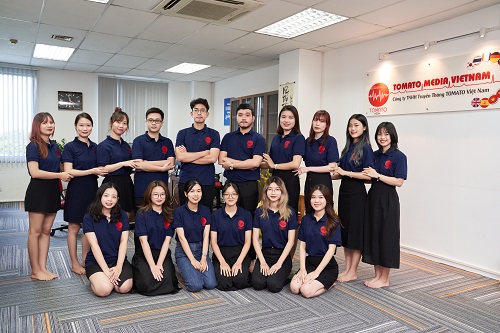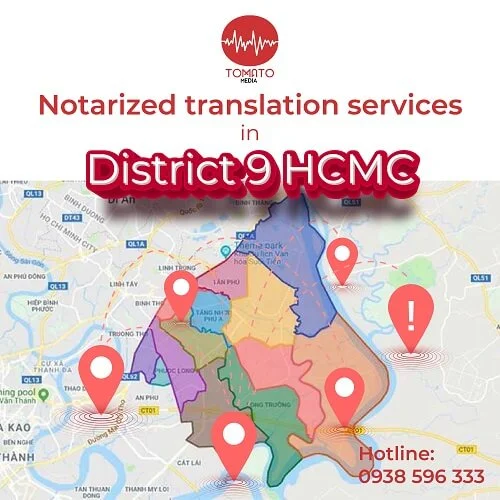Today, finding a notarized translation office in Ho Chi Minh City is not difficult. Because this place is considered a “fruitful land” for a number of translation companies that grow like mushrooms after rain but in fact not all companies are reliable. To help relieve you of your concern, Tomato would like to introduce the [...]
What is translation? Pay attention to accuracy for every word
The translation is a profession that requires high accuracy for each sentence. Translators must not only respect the message of the original language but also present the translation in a way that is “closest” to the culture of the source language, helping readers to understand and receive new information easily and conveniently.
NỘI DUNG (CONTENT)
What is translation

What is translation? Translation is the act of changing words from the source language (A) to the target language (B) in written form. Those performing the translation are called translators. In particular, the translation process has the support of different tools such as translation testing software, dictionaries, internet search engines, file format conversion application, etc.
Unlike interpretation, which requires a quick verbal translation of the whole sentence or speech, translation emphasizes translation accuracy. The translated sentence must be refined, coherent, and grammatically correct to fully convey the original message, thereby helping the reader grasp the semantics and understand what the writer wants to convey.
How important is translation?
The translation is an essential “bridge” for the reader to receive the writer’s information written in a non-mother tongue, providing an opportunity for them to better understand the history, culture, politics, geography, technology, cinema, and many other aspects of a new country or region in the world.
Notably, in the currently rapid and powerful process of globalization, translation is an indispensable profession for people to receive more interesting and useful content about advanced technologies in medicine, defense, education, production, etc. in many developed countries in the world.
Current types and methods of translation
In the past, translation was mainly done by humans, so it usually takes quite a long time to complete the translation. With the rapid development of information technology, many translation software programs have been created, helping to accelerate the translation process. At the same time, the translation is classified into several types, as follows:
1) 100% translation by the translator
Most users favor using a translator to translate their documents. A skilled translator can guarantee high accuracy in the translations as well as express the hidden meanings in the original in both literal and figurative terms.
Although the downside is that the time to prepare and translate is usually not short, the translation will take longer if the document is complex and contains a lot of specialized words.
2) Translation made by machine translation or translation software
Its speed and affordability are advantages. Just use translation software applications to translate without having to wait or pay service fees, even for free. However, you get what you pay for, and this type often comes with a lot of risks, such as unclear, incoherent, unreadable sentences and failure to deliver the meaning of the source document’s message.
3) Translation made by a combination of human translators and machine translation
In the digital age, the combined type of translation is now dominant in many translation projects. To perform, the translator can conduct text translation first, then combine professional translation software to check on grammar and spelling.
The above method helps optimize the translation process, ensure high accuracy for the text, and shorten the turnaround time for the translation. However, there is still a risk of errors if the translator abuses the translation software to speed up the delivery deadline.
With the above types of translation, the translation process usually applies one or all seven basic translation methods:
-
Borrowing technique: When the target language does not yet have a word that is semantically equivalent to the word in the source language.
-
Calque technique: used when it needs to produce new words in the target language from the original structure of the word in the original language.
-
Literary technique: the sentence is translated entirely or almost identically from the original language, except for the necessary changes in the grammar of the target language.
-
Transposition technique: replace one word of one type with another with a similar meaning without losing the value of the original message.
-
Modulation technique: Mostly applied to sentences that are grammatically correct in the original language but are difficult to understand or are not suitable for the target language.
-
Equivalence technique: commonly applied for languages that describe the same meaning but have different structures and methods of expression.
-
Adaptation technique: often applied for poetry, dramas, novels, and songs when the context to be translated is in the culture of the source language but does not exist in the target language culture.
The ultimate purpose when the translator uses the above methods is to ensure maximum accuracy of meaning for the original document. As a result, the translation can be coherent and clear, and the message can be conveyed fully in an understandable form with cultural relevance for the target language reader.
Translation (translation writing) for documents, papers
Up until now, the same types of translation methods have been applied mainly to the following types of documents:
-
Documents, papers, records to be notarized translation:
- Types of notarized personal documents: identity documents, visas or documents for study abroad, labor export, etc.
- Types of notarized business documents: types of commercial transaction contract, business registration certificates, patents, etc.
-
Translation of company capacity profiles: Catalogs, brochures, banners, profiles, etc.
-
Translation of books, newspapers, multi-specialized magazines: paper magazines, online newspapers, printed books, ebooks, etc.
-
Translation of various types of documents, scientific research reports, multi-specialized technical documents such as marketing, education, health, cosmetics, etc.
-
Theses, dissertations, essays: theses for bachelor/master, graduate course, etc.
-
Script translation, subtitling: movie script, TVC script, MV script, video, etc.
-
Translation of documents, papers, import and export documents: vouchers, insurance documents, bill of lading, certificate of quarantine, etc.
-
Translation of bid documents: bid documents, proof of eligibility to bid, etc.
-
Translation of types of financial statements, audits, and accounting: tax reports, cash flow reports, annual revenue reports, etc.
-
Translation of all kinds of contracts: individual civil transaction contracts, franchise contracts, purchase, sale, and lease of land or office contracts, commercial contracts, etc.
-
DTP translation for various file formats: word, excel, landing page, website, PDF, file code, etc.
-
MSDS document translation, etc.
How is translation different from interpreting?
You can rely on the comparison table below to find out the differences between these two types of translation.
| Comparison content | Translation | Interpreting |
| Translation methods | The written word | The spoken word |
| Duration | There is plenty of time to read the original, learn, and translate. In addition, the translator has plenty of time to edit the translation. | The translation time is almost instantaneous, and the interpreter almost does not have time to edit or review the translation. |
| Translation support tools | Many tools can be used, such as dictionaries, translation software, glossaries, spelling test software, etc. | There is no time to use the support tool. |
| Language skills | Strong writing and reading skills | Strong speaking and listening skills |
| Translation skills | Need good lookup skills | Memorization, analysis, and improvisation skills are required |
Skills and job requirements for the translation profession

To become a professional translator, the translator needs the following key skills.
- Language proficiency:
This is the key to becoming a professional translator. Without language proficiency, you won’t be able to do translation work.
- Qualification:
The translator must have a good professional background in the field of translation. For example, in specialties related to medicine, pharmaceuticals, cosmetics, or scientific research, a mistranslation of specialized documents may lead to a misunderstanding of knowledge, causing serious mistakes in medical examination or health care.
- Good writing skills:
Translators must have a good understanding of their native language, both in writing and speaking, to help them express standard sentences more fluently in the translation. It helps ensure that the reader does not feel too strange or confused when receiving new knowledge from the translation.
- Look-up skills and the ability to update information quickly
Translators must know how to apply word search fluently through online search tools such as translation software, internet search engines, or specialized dictionaries. If the lookup skills are not good, it is very difficult for translators to complete professional translations on time.
In addition, translators also have to regularly improve themselves by updating general news about culture, politics, geography, lifestyle, etc., in order to quickly grasp the changes in style and ways of expression from both the source language and the target language.
Because the translation is a job that requires high accuracy and standards in each word and paragraph, translators have to be extremely careful when translating and checking for errors. Carelessness in translation not only leads to a waste of money, time, and effort but also causes the translation to lose its value.
Along with a quality translation, the translator must also have a professional working attitude, know how to arrange a scientific timetable, and always respect the deadline. Notably, translators should respect professional ethics as well as be fully loyal to the original content and message; they should not arbitrarily edit or add personal opinions to the translation.
What functions do language solution providers (LSPs) have?
Nowadays, the majority of translators choose to collaborate part-time or officially with translation units, also known as language solution providers (LSPs), because these are businesses that provide a lot of practical support to translators and customers.
-
Find the right translator for the field of text to be translated: LSPs assist customers in finding a translator who is qualified for the field to be translated, and translators do not need to spend time searching for translation jobs whose specialization is suitable for them.
-
Guaranteed delivery time as well as translation warranty policy: Translators who cooperate with LSPs don’t have to cope with inappropriate deadlines from customers who are not knowledgeable about the industry. LSPs help the translator to reach a reasonable agreement on the translation turnaround time, and the customer also feels assured to send their documents to a credible agency where the progress and accuracy of the translation are guaranteed.
-
High confidentiality of the document: the information about the project is kept completely confidential through the management system of the translation company, along with the commitment to take all responsibilities if any violations arise as agreed with customers.
Difficulties in the translation of documents
Any occupation presents certain challenges, and the translation profession is no exception. For this profession, the most common difficulties are vocabulary and semantics, such as:
-
Separate language systems: each language has its own morphology of sentence structure, syntax, and morphemes, which makes it difficult for the translator to translate.
-
Lack of specialized legal terms in the target language: many legal words are present in the original language but do not exist in the legislation of the target language.
-
Different legal systems of the two countries: translators do not understand the provisions of the legal systems in the country of the source language and the country of the target language, which may cause mistakes in notarized translations.
-
Other challenges: include using slang, idioms, rare ancient words, and familiar phrases in sentences with different contexts to imply a particular message.
Cost-saving online translation trends for individual and corporate customers

The explosion of digital technology and the complex situation of the COVID-19 pandemic have caused many traditional compilation trends to change. Online translation or online translation is therefore becoming more and more well-known.
This form of translation freed the client from having to visit translation centers in person. The issues of cost, delivery time, and warranty can be agreed upon via email and chat software, including text translation. Customers only need to send a soft file with full details of the original document via email. The translation company then assigns it to the translator for translation and hands over the completed translation in soft file format by email.
Online translation services are helpful in this challenging time, saving clients a ton of time and money on travel expenses while also ensuring their health and safety.
The key to successful translations
The key to creating success in the translation profession is the level and knowledge of the translator. In order to be able to perfect the translation in the most accurate way, translators must continuously improve their professional skills in the profession, particularly their language skills, writing skills, and information lookup and update skills. Besides, they need to be careful in every detail during the translation to minimize possible errors.
In order to diversify their knowledge and make the translation process run more smoothly, they have to constantly add new information, such as news about translation, culture, the economy, and many other fields.
Hopefully, with the above information, you now somewhat better understand what translation is, what a translator does, and the skills required of a translator.

















